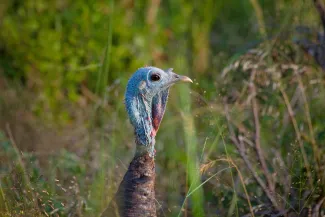
Wild turkey hen.
Since severe drought conditions persisted across our state in 2012 and 2013, Oklahoma’s hunters and biologists have noticed what they feel is fewer turkeys roaming our diverse landscape. Wild turkey survey and harvest data support this observation. The situation is more severe with Rio Grande turkey populations in the western half of the state. Though still under historical numbers, eastern turkey numbers have stabilized in the past couple of years.
Because of this concern, the Wildlife Department has prioritized turkey research as a critical need, resulting in a research partnership with Oklahoma State University to address turkey population concerns. As of January 1, the OSU research team put their work boots on the ground to begin a 4 ½-year investigation to address wild turkey population dynamics and brood survival. In order to get answers for why our turkey population has declined, this research will take a very intentional and stepwise look at several important life stages of the species, with the hope of finding variables impacting the population at each step in the life of a wild turkey.
The researchers will begin by capturing hen turkeys in nets, attaching a backpack-style VHF telemetry transmitter, and then locating the hens in April and May when the birds are nesting. Turkey nests will be closely observed to determine hatching success, nest abandonment, and any nest predation. This nesting information is critical to find out if low nesting success rates are contributing to a turkey population decline.
Next, when turkey poults have hatched, researchers will briefly collect poults and equip them with miniature backpack transmitters, then return them to the hen. Poult transmitter data will provide researchers with a better understanding of the causes of poult mortality in the first 2 – 3 months of life. As with nesting data, this early life information will help researchers identify the major impediments to newly hatched turkeys surviving into adulthood.
The final component of the research effort will be to closely look at the genetic diversity and integrity of Oklahoma turkeys. Genetic samples will be obtained from hunters willing to donate the wing of a harvested bird, so no additional turkeys will need to be taken outside of those legally harvested. Genetic analysis of turkey feathers will shed light on potential issues such as population fragmentation, connectivity barriers like roads or other human developments, and possible hybridization between Rio Grande and eastern wild turkeys. This broad genetic analysis should give a detailed look at turkey population health and sustainability without having to collect a huge sample size of individuals.
The Wildlife Department is confident that its strong relationship with the OSU research team will yield important data and meaningful results. Biologists are ready to use the results and recommendations from this research effort to improve turkey numbers through enhanced land management practices, turkey habitat improvements, and possibly adaptive regulatory strategies. Hunters will be the primary beneficiaries of this collaborative effort, and rightly so given that the project is funded through the Wildlife Restoration Program, supported by hunters purchasing licenses and hunting equipment.